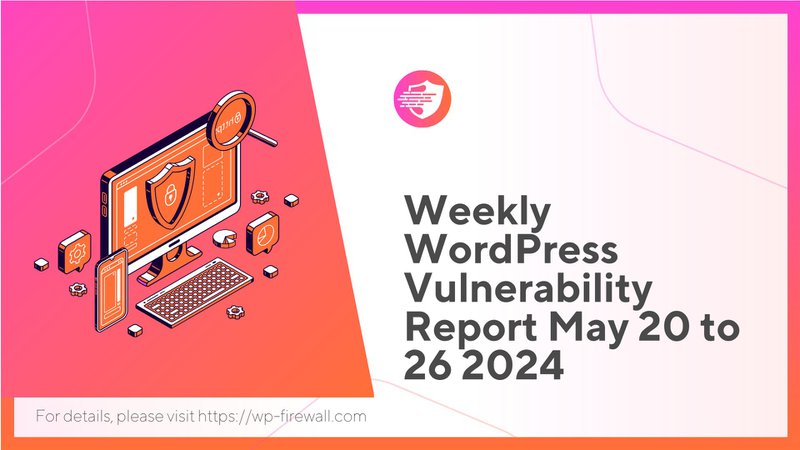
WordPress 雙週漏洞報告:2024年5月20日至2024年5月26日
介紹
歡迎閱讀我們全面的 WordPress 雙週漏洞報告。該報告旨在讓 WordPress 網站管理員了解最新的安全威脅,幫助保護他們的網站免受潛在攻擊。該報告涵蓋2024年5月20日至26日期間,概述了新發現的漏洞、其影響以及緩解這些威脅的最佳實踐。在不斷發展的網路安全環境中,及時了解漏洞對於維護網站安全和保護用戶資料至關重要。
關鍵漏洞總結
在此報告期間內,110 個 WordPress 外掛和 1 個主題中總共發現了 134 個漏洞。其中,99個漏洞已修復,35個漏洞尚未修復。這些漏洞的嚴重程度各不相同,其中 108 個漏洞為中等嚴重程度,19 個為高嚴重程度,7 個為嚴重漏洞。
嚴重漏洞
1. 業務目錄外掛 – WordPress 的輕鬆列出目錄 (<= 6.4.2)
– 類型: 未經身份驗證的 SQL 注入
– CVSS 評級: 9.8
– 地位: 已修補
2. 國家/州/城市下拉清單 CF7 (<= 2.7.2)
– 類型: 未經身份驗證的 SQL 注入
– CVSS 評級: 9.8
– 地位: 已修補
3. 哈希表單 – 拖放表單產生器 (<= 1.1.0)
– 類型: 未經身份驗證的任意檔案上傳至遠端程式碼執行
– CVSS 評級: 9.8
– 地位: 已修補
4. Pie Register – 社群網站登入(附加)(<= 1.7.7)
– 類型: 身份驗證繞過
– CVSS 評級: 9.8
– 地位: 已修補
5. UserPro – 社群和使用者設定檔 WordPress 外掛程式 (<= 5.1.8)
– 類型: 未經身份驗證的帳戶接管以提升權限
– CVSS 評級: 9.8
– 地位: 已修補
6. 網路目錄免費 (<= 1.6.9)
– 類型: 未經身份驗證的 SQL 注入
– CVSS 評級: 9.8
– 地位: 已修補
7. Elementor 的 WPZOOM 外掛程式(模板、小工具)(<= 1.1.37)
– 類型: 未經身份驗證的本機文件包含
– CVSS 評級: 9.8
– 地位: 已修補
漏洞詳細分析
1. SQL注入漏洞:
SQL 注入漏洞是最嚴重的漏洞之一,因為它們允許攻擊者在資料庫上執行任意 SQL 查詢。這可能導致未經授權存取敏感資料、資料庫操縱,甚至完全接管網站。 Business Directory、Country State City Dropdown CF7 和 Web Directory Free 等外掛程式中發現的 SQL 注入漏洞可能允許攻擊者利用資料庫漏洞而無需進行驗證。
2. 任意文件上傳漏洞:
Hash Form – Drag & Drop Form Builder 中的漏洞允許攻擊者上傳任意文件,然後可以在伺服器上執行該文件。此類漏洞的破壞性特別大,因為它可能導致遠端程式碼執行,從而使攻擊者能夠完全控制網站。
3. 身份驗證繞過漏洞:
Pie Register – 社群網站登入中發現的漏洞可能允許攻擊者繞過身分驗證機制,從而授予他們對使用者帳戶的未經授權的存取權限。在某些情況下,這也可能導致權限升級,攻擊者獲得管理存取權限。
4. 本機檔案包含漏洞:
WPZOOM Addons for Elementor 外掛程式漏洞允許攻擊者在伺服器上包含本機檔案。這可以用來讀取敏感文件,例如包含資料庫憑證的設定文件,或執行惡意腳本。
漏洞的影響
發現的漏洞為 WordPress 網站帶來重大風險,包括:
– 資料外洩: 攻擊者可以存取資料庫中儲存的敏感信息,從而導致潛在的資料外洩並損害用戶隱私。
– 網站污損: 任意檔案上傳和程式碼執行漏洞可用於變更網站內容、破壞網站或註入惡意內容。
– 惡意軟體感染: 利用這些漏洞可能會導致惡意軟體的部署,這些惡意軟體可能會傳播到訪客和網站的其他部分,從而導致更廣泛的安全問題。
– 服務中斷: 成功的攻擊可能會導致停機、服務中斷並對使用者體驗和信任產生負面影響。
緩解措施和建議
為了保護您的 WordPress 網站免受這些漏洞的影響,必須遵循以下最佳做法:
1. 定期更新:
– 確保所有外掛程式和主題都更新至最新版本。開發人員經常發布修補程式來修復已知漏洞,因此保持網站更新至關重要。
2. 實施 強而有力的安全措施:
– 對所有使用者帳戶使用強而獨特的密碼,並啟用雙重認證 (2FA) 以提供額外的安全層。
– 安裝信譽良好的安全插件,例如 Wordfence,以監控和保護您的網站免受各種威脅。
3. 定期備份:
– 定期備份您的站點,以確保您可以在遭受攻擊或資料遺失時快速復原。將備份儲存在安全的異地位置。
4. 監控站點活動:
– 定期查看您的網站和#x27;的日誌和活動報告,以識別任何異常行為或潛在的安全威脅。針對可疑活動設定警報。
5. 限制存取:
– 將對 WordPress 管理區域的存取權限限制為受信任的 IP 位址,並將使用者角色限制為最低必要權限。
WP-防火牆簡介
WP-Firewall 提供全面的解決方案來保護您的 WordPress 網站免受漏洞和威脅。免費方案包括基本的安全功能,例如:
– 即時威脅偵測: 監控並阻止惡意活動的發生,確保您的網站全天候受到保護。
– 防火牆保護: 防止未經授權的存取並防禦常見的基於 Web 的攻擊,例如 SQL 注入和跨站點腳本 (XSS)。
– 惡意軟體掃描: 定期掃描您的網站是否有惡意軟體,在惡意程式碼造成損害之前識別並刪除它。
– 自動更新: 自動更新您的外掛程式和主題,確保您始終擁有最新的安全性修補程式。
WP 防火牆的優點
使用 WP-Firewall 具有許多優勢,包括:
1. 增強安全性:
– WP-Firewall 提供各種威脅的進階保護,有助於保護您的網站免受已知和新出現的漏洞的影響。
2. 改進的性能:
– 透過阻止惡意流量並減少伺服器負載,WP-Firewall 可以幫助提高網站的效能和穩定性。
3. 安心:
– 透過 WP-Firewall 主動保護您的站點,您可以專注於創建內容和經營業務,並知道您的站點是安全的。
4. 減少維護工作量:
– 自動更新和定期掃描意味著管理安全性所花費的時間更少,而有更多時間用於其他重要任務。
案例研究:WP-防火牆的實際應用
1. 案例研究1:
– WordPress 電子商務網站經常受到 SQL 注入攻擊,導致資料外洩和客戶抱怨。實施 WP-Firewall 後,該網站的攻擊次數顯著減少,且沒有進一步的資料外洩。
2. 案例研究2:
– 一個受歡迎的部落格因文件上傳漏洞而多次遭到篡改。 WP-Firewall ' 的即時威脅偵測和惡意軟體掃描有助於防止進一步的事件並恢復網站 ' 的完整性。
還在等什麼?立即增強您的 WordPress 網站安全等級!
立即註冊 WP-Firewall 免費方案來保護您的 WordPress 網站。主動安全措施對於維護網站的完整性和安全性至關重要。不要等到為時已晚——註冊 WP-Firewall 免費計劃並確保您的網站保持安全,免受最新威脅。
結論
在本報告中,我們重點介紹了 2024 年 5 月 20 日至 2024 年 5 月 26 日期間發現的關鍵漏洞、其潛在影響以及緩解這些漏洞的必要步驟。隨時了解漏洞並採取主動措施來保護您的 WordPress 網站至關重要。 WP-Firewall 提供全面的保護,幫助您保護您的網站並讓您高枕無憂。立即註冊,讓您的 WordPress 網站的安全性成為首要任務。

